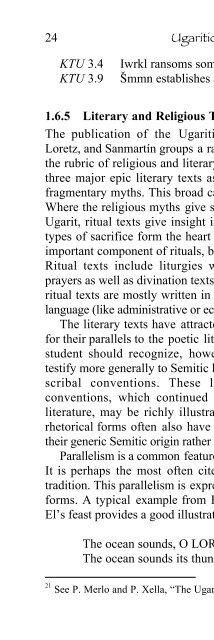A Primer on Ugaritic: Language, Culture, and Literature - enenuru
A Primer on Ugaritic: Language, Culture, and Literature - enenuru
A Primer on Ugaritic: Language, Culture, and Literature - enenuru
Create successful ePaper yourself
Turn your PDF publications into a flip-book with our unique Google optimized e-Paper software.
24<br />
<strong>Ugaritic</strong> <str<strong>on</strong>g>Primer</str<strong>on</strong>g><br />
KTU 3.4 Iwrkl ransoms some captives<br />
KTU 3.9 SÁmmn establishes a marzih˙u<br />
1.6.5 Literary <strong>and</strong> Religious Texts (Chapter 6)<br />
The publicati<strong>on</strong> of the <strong>Ugaritic</strong> alphabetic texts by Dietrich,<br />
Loretz, <strong>and</strong> Sanmartín groups a rather diverse group of texts under<br />
the rubric of religious <strong>and</strong> literary texts (= KTU 1). It includes the<br />
three major epic literary texts as well as a variety of shorter or<br />
fragmentary myths. This broad category also includes ritual texts.<br />
Where the religious myths give some insight into the theology at<br />
Ugarit, ritual texts give insight into religious practices. 21 Various<br />
types of sacrifice form the heart of ritual texts. Blood is often an<br />
important comp<strong>on</strong>ent of rituals, but there are also bloodless rituals.<br />
Ritual texts include liturgies with invocati<strong>on</strong>s, recitati<strong>on</strong>s, or<br />
prayers as well as divinati<strong>on</strong> texts, oracles, <strong>and</strong> expiati<strong>on</strong> rites. The<br />
ritual texts are mostly written in a chancellery or formal style <strong>and</strong><br />
language (like administrative or ec<strong>on</strong>omic texts).<br />
The literary texts have attracted the most attenti<strong>on</strong>, especially<br />
for their parallels to the poetic literature of the Hebrew Bible. The<br />
student should recognize, however, that these parallels really<br />
testify more generally to Semitic literary traditi<strong>on</strong> <strong>and</strong> Near Eastern<br />
scribal c<strong>on</strong>venti<strong>on</strong>s. These literary traditi<strong>on</strong>s <strong>and</strong> scribal<br />
c<strong>on</strong>venti<strong>on</strong>s, which c<strong>on</strong>tinued into the Ir<strong>on</strong> Age <strong>and</strong> biblical<br />
literature, may be richly illustrated in <strong>Ugaritic</strong> literature. These<br />
rhetorical forms often also have parallels in Akkadian, suggesting<br />
their generic Semitic origin rather than specifically Canaanite.<br />
Parallelism is a comm<strong>on</strong> feature of <strong>Ugaritic</strong> <strong>and</strong> Hebrew poetry.<br />
It is perhaps the most often cited example of a comm<strong>on</strong> literary<br />
traditi<strong>on</strong>. This parallelism is expressed in several distinct rhetorical<br />
forms. A typical example from Psalms <strong>and</strong> the <strong>Ugaritic</strong> poem of<br />
El’s feast provides a good illustrati<strong>on</strong>:<br />
The ocean sounds, O LORD,<br />
The ocean sounds its thunder,<br />
21 See P. Merlo <strong>and</strong> P. Xella, “The <strong>Ugaritic</strong> Cultic Texts,” in HUS, 289–304.


